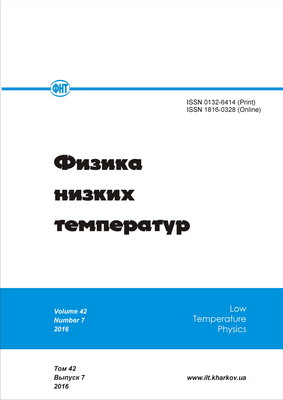Antonov V. N.
Electronic structure and x-ray magnetic circular dichroism in A2CrB′O6 (A = Ca, Sr; B′ = W, Re, and Os) oxides / V. N. Antonov, L. V. Bekenov // Физика низких температур. - 2017. - Т. 43, № 5. - С. 724-737. - Режим доступу: http://nbuv.gov.ua/UJRN/PhNT_2017_43_5_10
The electronic structure and x-ray magnetic circular dichroism (XMCD) spectra of US, USe, and UTe are investigated theoretically from first principles, using the fully relativistic Dirac LMTO band structure method. The electronic structure is obtained with the local spin-density approximation (LSDA), as well as with a generalization of the LSDA+U method which takes into account that in the presence of spin - orbit coupling the occupation matrix of localized electrons becomes non-diagonal in spin indexes. The origin of the XMCD spectra in the compounds is examined.The electronic structure and x-ray magnetic circular dichroism (XMCD) spectra of the Heusler alloy Co2FeSi were investigated theoretically from first principles, using the fully relativistic Dirac linear MT-orbital band structure method. Densities of valence states, orbital and spin magnetic moments as well as polarization of the electronic states at the Fermi level are analyzed and discussed. The origin of the XMCD spectra in the Co2FeSi compound is examined. The calculated results are compared with available experimental data.На підставі розрахунків повністю релятивістським діраківським лінійним методом МТ-орбіталей теоретично з перших принципів досліджено електронну структуру розбавлених магнітних напівпровідників (Ge,Mn)Te. Розрахунки проведено як у наближенні локальної спінової густини (LSDA), так і методом LSDA+U. Теоретично з перших принципів досліджено Mn <$E L sub 2,3> спектри рентгенівського магнітного циркулярного дихроїзму (РМЦД) у сполуці (Ge,Mn)Te. Вивчено походження спектрів РМЦД. Результати розрахунків порівняно з наявними експериментальними даними.The electronic and magnetic structures of Mn3CuN are investigated theoretically from first principles using the fully relativistic Dirac LMTO band structure method. Mn3CuN possesses a magnetic phase transition at Tc = 143 K from a high temperature paramagnetic phase to a low temperature ferromagnetic one with a noncollinear magnetic structure. The transition is accompanied by a structural change from the cubic to the tetragonal lattice. In low temperature phase two Cu moments and two Mn moments (Mn2 and Mn3) ferromagnetically align along the c axis while other four Mn1 magnetic moments are canted from the c axis to [111] direction by angle <$E THETA~=~symbol С~76,2>. The x-ray absorption spectra and x-ray magnetic circular dichroism (XMCD) spectra of Mn3CuN are investigated theoretically from first principles. The origin of the XMCD spectra in the Mn3CuN compound is examined. The calculated results are compared with the experimental data.A systematic electronic structure study of <$E {A sub 2 CrB prime O sub 6}> (A = Ca, Sr; <$E roman {B prime~=~W,~Re}>, and Os) has been performed by employing the local spin-density approximation (LSDA) as well as the GGA and LSDA + U methods using the fully relativistic spin-polarized Dirac linear muffin-tin orbital band-structure method. We investigated the effects of the subtle interplay among the spin-orbit coupling, electron correlations, and lattice distortion on the electronic structure of the double perovskites. First principles calculations predict that Sr2CrOsO6 is (before considering spin-orbit coupling) actually a ferrimagnetic semimetal with precisely compensating spin moments, or spin-asymmetric compensated semimetallic ferrimagnet in which the electrons and holes are each fully polarized and have opposite spin directions, in spite of a zero net moment and hence no macroscopic magnetic field. Spin-orbit coupling degrades this by giving a nonzero total moment, but the band structure is little changed. Therefore, the observed saturation moment of ferrimagnetic Sr2CrOsO6 is entirely due to spin-orbit coupling. The x-ray absorption spectra and x-ray magnetic circular dichroism at the W, Re, Os, and Cr L2,3, and Cr and O K edges were investigated theoretically from first principles. A qualitative explanation of the XMCD spectra shape is provided by the analysis of the corresponding selection rules, orbital character and occupation numbers of individual orbitals. The calculated results are in good agreement with experimental data. The complex fine structure of the Cr L2,3 XAS in Sr2CrWO6 and Sr2CrReO6 was found to be not compatible with a pure Cr<^>3+ valency state. The interpretation demands mixed valent states. We found that possible oxygen vacancies lead to a mixed valency at the Cr site, double peak structure at the Cr L2,3 edges and reduce the saturation magnetization in Sr2CrWO6 and Sr2CrReO6.
Цитованість авторів публікації:Antonov V.Bekenov L.
Бібліографічний опис для цитування: Antonov V. N. Electronic structure and x-ray magnetic circular dichroism in A2CrB′O6 (A = Ca, Sr; B′ = W, Re, and Os) oxides / V. N. Antonov, L. V. Bekenov // Физика низких температур. - 2017. - Т. 43, № 5. - С. 724-737. - Режим доступу: http://nbuv.gov.ua/UJRN/PhNT_2017_43_5_10.
Додаткова інформація про автора(ів) публікації:
(cписок формується автоматично, до списку можуть бути включені персоналії з подібними іменами або однофамільці)Антонов Віктор Миколайович (1947–) (фізико-математичні науки)
 Якщо, ви не знайшли інформацію про автора(ів) публікації, маєте бажання виправити або відобразити більш докладну інформацію про науковців України запрошуємо заповнити "Анкету науковця"
|



